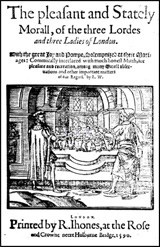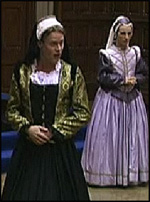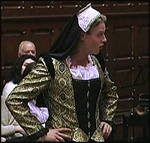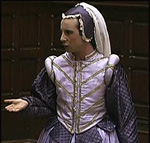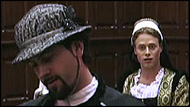- Edition: King Leir
King Leir
- Introduction
- Texts of this edition
- Contextual materials
- Facsimiles
11King Leir, Scene 2
12Cast
Ragan: Derek Genova
Gonorill: Matthew Krist
Skalliger: David Kynaston
Performing Gonorill and Ragan: Characters or Vices
13My direction to the "boys" playing these women was to think of these characters as the wicked sisters in a Cinderella pantomime. I wanted them to be the Vices to Cordella's Virtue. Having worked on Robert Wilson's The Three Ladies of London in preparation for the SQM productions, I was curious about the possible connection between the women in Leir and in Wilson's play, which shows how the Vice Lady Lucre corrupts the Virtues Lady Love and Lady Conscience. Wilson became a Queen's man and his play could have been part of the company repertoire as was its sequel: The Three Lords and Three Ladies of London. The same actors may well have played the female roles in Wilson's plays and in King Leir. Would the original actors have approached their performances in the morality play and the romance differently or would they have treated the characters in similar fashion?
14 Our twenty-first century actors initially followed their own familiar process, searching the text for evidence to motivate their characters; specifically, they focused on the fact that Cordella is a favorite at court (TLN 107-108), on the accusation that she imitates their innovative fashions (TLN 101-104), and on their fear that she may take a husband first and be granted pre-eminence over them (TLN 115-120). There are solid grounds for psychological motivation here but, in my effort to emphasize historical difference, I encouraged the actors simply to enjoy the presentation of their characters' wickedness rather than perform any justification. Conceiving the characters as representations of virtues and vices pushed the company away from their modern milieu of psychological realism and encouraged them to experiment with alternative approaches to performing. In this scene, they played Gonorill and Ragan as the vices Envy and Pride.
Watch video of Scene 2 on the Performing the Queen's Men website. (The video footage is password protected. Click on "Cancel" in the pop-up window to obtain password.)
16Building on an perceived sexual innuendo on the word "nothing" in Scene 6 (TLN 490-492) the "boys" also played up their characters' sexuality in this scene. When Gonorill swore by her "virginity" (TLN 121), Krist's delivery implied that either she was no longer a virgin, or that the loss of her virginity could not come a moment too soon. Ragan responded in like fashion when imploring her sister to "Swear not so deeply" (TLN 126) giving the line an anatomical inference. The "boys'" performances conflated the characters' sexual desires with their political aggression and thus played into conservative patriarchal assumptions about the dangers of female sexuality. Such moments of overt sexuality made me most aware of the politics of representation brought into play when "boys" play women. I saw them as always performing women in quotation marks, framed by the perspective of their own gender and biased accordingly. Others on the SQM team argue that the gender of the actor became immaterial in performance. You may come to your own opinion by watching video of the "boys" in action.
Read more about performing Gonorill and Ragan
Watch video of scene 2 on the Performing the Queen's Men website. (The video footage is password protected. Click on "Cancel" in the pop-up window to obtain password.)
Queen's Men Dramaturgy: Narrative Over-Determination
17Unlike Gonoril and Regan in King Lear the Queen's Men's sisters reveal their aggressive and deceptive intentions from the start. Their target is their sister Cordella. Once their course of action is established they spend the remainder of the scene gloating over their anticipated revenge on their "proud" sister. Their clarity of purpose and the action that follows illustrates their dramaturgy, typical of the Queen's Men, which McMillin and McLean refer to as "narrative over-determination". The characters tell us exactly what they are going to do and in the next scene we see them do just that. Performing them as Vices or pantomime villainesses added to the sense of "over-determination" as Vice characters are certain to behave viciously. The sisters' openly wicked intentions raise clear expectations of the action which then unfolds with the pleasurable predictability of a fairy tale, pleasing through the resolution of conventional narrative expectations rather than unexpected twists and turns.
18Although the actors had plenty of information on which to build psychological motivation in this scene, the SQM company developed a style that was more demonstrative and pantomimic. While the interpretation lacked subtlety and complexity, the actors' relish of their characters' wickedness brought its own pleasures as may be seen in the video of the performance.
Read more about narrative over-determination
Watch video of scene 2 on the Performing the Queen's Men website. (The video footage is password protected. Click on "Cancel" in the pop-up window to obtain password.)
Performing Skalliger: Type characters and the Twenty-First Century actor
19Read about Kynaston's performance of Skalliger in the first scene.
20 David Kynaston's application to the character of Skalliger in the early stages of our production process is typical of the twenty first century rehearsal practice and also indicative of the necessarily different approach that must have been a part of the original actor's technique. Skalliger claims in this scene that Leir has confessed "in great secrecy" (TLN 134) details of the marriage plans for his daughters, plans that were not shared in the previous court scene. This evidence led Kynaston to wonder when exactly did his character speak to the king about the marriage schemes? His exit line in the previous scene (TLN 92) implies that Skalliger hurries here directly. If he had done so, reasoned Kynaston, then the secret conference with the king must have occurred prior to the opening scene of the play and, on the basis of this deductive reasoning, Kynaston decided that Skalliger enjoys a privileged relationship with the king. Kynaston also noted the inconsistency when Skalliger says "I am glad I met you here so luckily" (TLN 134) implying an accidental meeting when he left the previous scene with the express intention of finding them.
21 Kynaston built a convincing performance of the manipulative Skalliger through his careful application to textual evidence but his investigative process would have been impossible in the rehearsal conditions of early modern theatre. The Queen's Men largely rehearsed alone and with only their parts in hand. Kynaston's elaborate cross-referencing depends on easy access to the full text and repeated rehearsal of the scene. Without these options, it is likely that the original actor would have identified the character as a familiar type: the Machiavel. An actor familiar with the type and confident in its performance conventions can learn his lines and walk out on the stage to speak them with conviction with minimal rehearsal. As the SQM project progressed and less and less time was available for rehearsal the actors became increasingly reliant on this approach to characterization.
22Reliance on type characters can lead to simplification and a lack of psychological complexity but the simplicity of the approach held an honest charm and it was unquestionably efficient. In this instance, psychological complexity was not required for the performance of Skalliger, who has a short-lived and relatively straightforward function to perform in the telling of the story. The time spent on this in rehearsal was really time wasted.
Read about performing Skalliger's final appearance in the play
23Watch David Kynaston describe how he felt the extra rehearsal spent on Leir in comparison to other plays proved damaging in the end, on the Performing the Queen's Men Website.
Watch video of scene 2 on the Performing the Queen's Men website. (The video footage is password protected. Click on "Cancel" in the pop-up window to obtain password.)

